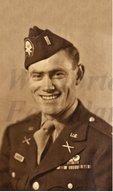
|

|
|
|
|
George was born on a farm near Minden, Louisiana, as one of two sons to John K. Turner and Lola Monzingo. A first cousin, Harold Monzingo, came to live with them when, as an infant, his parents died. "We considered him to be a brother," George recalls. His family was devout, he recalls. "I was born into a Christian family," he says. "My mother and daddy were both Christians and they saw that I got to church and Sunday School every Sunday," he says. They taught him the scriptures and "read the Bible at night before we went to bed." George's father owned a sawmill, but also ran the farm. George plowed with a mule and did other farm chores. Although he grew up in the 1930s, he says "we didn't know we were in a Depression." The family ate well from its garden, cured pork with salt and smoke, listened to a battery-operated radio, lit their home with coal oil lamps, and visited friends on Sunday afternoon by wagon. They had no automobile. "We didn't have anything but a mule," he says. He graduated from Minden High School in 1937 and enrolled at Louisiana Tech in Ruston, studying agribusiness. On January 3, 1940 he married Ruth Duvall. They would have two children, four grandchildren, and five great-grandchildren. George worked in his uncle's grocery store while his wife worked at a general store, West Brothers. Each earned $12 a week. "We got married and rented this apartment and furnished it with furnishings and lived pretty good on twenty-five dollars a week," he says. He and Ruth had moved to New Orleans where he was working at a state employment office when Japanese forces attacked Pearl Harbor. Drafted into the U.S. Army on February 16, 1942, he took basic training at Camp Claiborne near Forest Hill, Louisiana. He and two other men from the Minden area, Doug Inabinett and Tinsley Connell, were placed in the 101st Airborne Division and were sent to glider training at Fort Bragg in Fayetteville, North Carolina. He recalls the training as "pretty hard," including 25-mile hikes. He was tabbed as a forward observer for an artillery unit of 75-millimeter guns. Meanwhile, Ruth found lodging at both Camp Claiborne and Fort Bragg, although, George recalls, he did not get much leave time. He was sent overseas in 1943 to a camp near Newbury, England, where he trained until D-Day. George arrived with his battery (Battery B) in Normandy on D+1, June 7, 1944, slogging ashore at Utah Beach. "They were still shooting at us," he says. "We waded in water up to our necks from the landing craft." George participated in the Normandy campaign for about 30 days. The unit returned to England, then participated in Operation Market Garden in Holland from September to November of 1944. On December 19, they moved on to Bastogne, where he earned a Bronze Star. During that struggle, when German forces surrounded the city, George says he never felt he was trapped. "We were pretty well able to defend the position," he says. "We never thought about it." After Bastogne, he says, "the war was pretty well over from the standpoint of heavy resistance. We just did kind of mopping-up type of operations after that." Of his coming through the war unscathed he says, "The Lord blessed me. He took care of me. And I had a wife who prayed for me. And I had a mother who prayed for me and the Lord answered their prayers." George was discharged at Camp Shelby near Hattiesburg, Mississippi, on October 15, 1945 as a first lieutenant. He returned to Minden, and after two weeks went to work at his pre-war job with the state employment agency. He also worked in a similar position in Shreveport, retiring in 1980 after 40 years. Meanwhile, late in life, he returned to Louisiana Tech and earned his degree in 1972. He also spent several years in the National Guard. |


